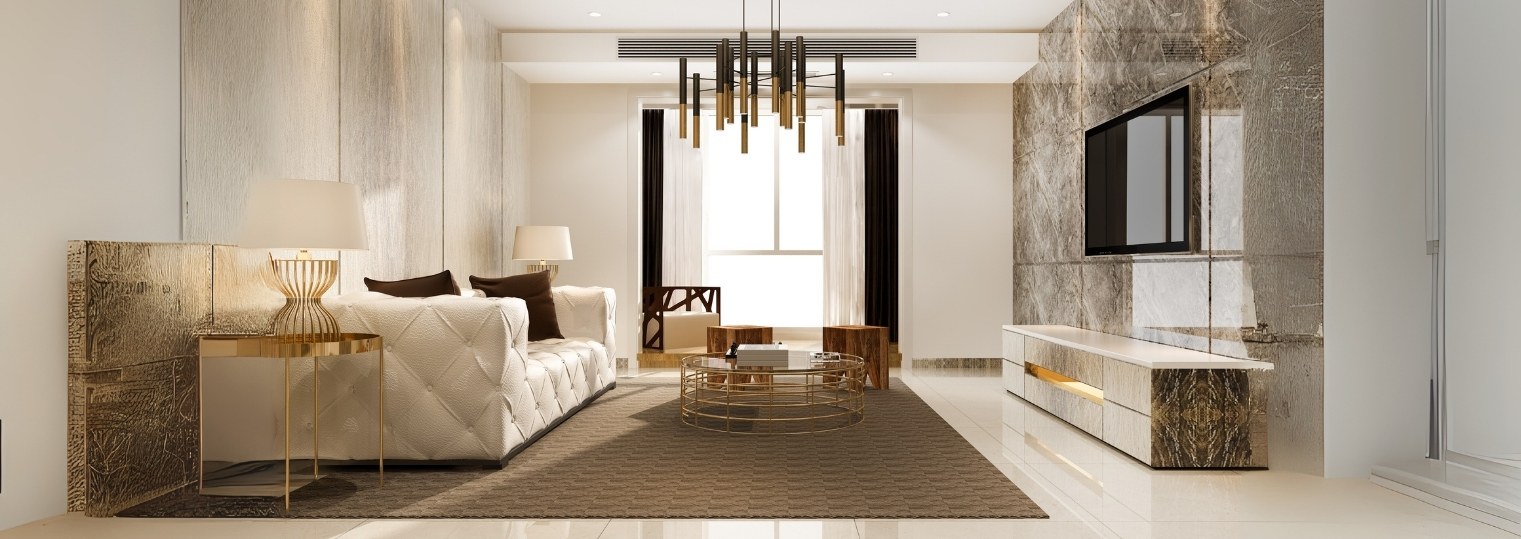But home design is about more than just getting the color right or finding the perfect piece of furniture; we’ve all stood in countless hardware stores and debated whether “Desert Sand” might go better with the carpet than “Almond Buff.” It is about creating a habitat in every sense of the word—that is, a habitat for humans. Well-designed homes should be able to host a feast for the senses; they should offer a stimulation and soothing sight, sound, smell, taste, and touch.
Now, before you start to believe I am going to turn all New Age on you, consider our senses and how they are put to use in our everyday lives. Were you ever in a room for the first time and immediately at ease because of the lighting and plush textures? Or perhaps dining on a wave of nostalgia at the scent of freshly baked bread? That’s the magic of sensory design; an archaic approach, though much neglected in the hurry to follow the recent design mantras.
Take, for example, ancient Indian architecture. Houses were not just to be built; they begged to be lived in, to be experienced and enjoyed. The forecourts of old-country Indian homes were not just a showpiece; that was the space where the family gossiped, wind-chimes filled the air with their music, the fragrance of jasmine, and the cool touch of marble underfoot that brought relief to a certain extent from the summer heat. Spaces in which all the five senses are inevitably used to design a wholesome environment that, therefore, nourishes both the body and soul.
Nowadays, enough of us have forgotten designing for the senses and moved toward a more minimalist and interior solution that winks one eye at technology. But not to fear — this blog is here to help make a home beautiful to look at and a real delight to live in. We will talk about how you can engage all of your five senses—sight, sound, smell, taste, and touch—such that your home becomes a place where each moment seems like an experience to savor.

To get started, I think we give most of the due to the sense of sight when it comes to interior design. Decoration of living spaces gets most of our attention from visual attractiveness, but there is more to it than just selecting colors and furniture.
Colour is a powerful tool meant to evoke different emotions or set the tone of a room. However, in a traditional Indian home, colour went beyond aesthetics and held cultural and spiritual significance. The heavy use of deep reds and yellows during festivals is simply to evoke the feeling of warmth and happiness, while cool blues and greens associate with calm and tranquility.
Colour in any room of the modern house can be used to evoke a given mood. Would you like your bedroom to be calming and peaceful? Then consider the quiet tones of soft blues and greys. Or perhaps you want to add a punch of colour to your living or family room? Take a look at vibrant yellows or rich oranges. The top tip is to use bold colours and neutralise with pastels or neutrals so as not to over stress the eye.
Lighting isn’t just functional; it is all about the difference between the warm, soft, and beautiful glow of the Diwali diya or the soft, diffused light seeping through that jali screen. Light can drastically affect how a space feels.
Layer ambient, task, and accent lighting to create an immersive atmosphere in the space. Mix in intensity with dimmable and alternatively dimmable fixtures, and layer in statement items always. Ideally, the design outcome is to create an environment that lights and brings drama to the best features of the space.
Natural Indian temples pride themselves on their lighting, being the most prominent feature. Traditionally, the play of shadow and light was done in a manner that was intended to build reverence and awe. This could easily be an imitation of what you see through lighting in your room to accentuate some architecture or bring much-needed focus that guides the eye and mood.

Sound may not be one of the first factors to consider in design, but it is in the end essential for creating a human-friendly and comfortable environment. Be it the sound of a water fountain or the fluid sound derivative from some piece of background music, sound can deteriorate one’s experience of a home.
The typical Indian home would have thick walls, and the heavy curtains would dam the outside noise, making it very quiet and peaceful inside. In today’s modern homes—open-plan living—it is possible for sound to travel easily, causing much annoyance.
Utilise noise-tolerant materials, such as carpets, curtains, and upholstered furniture, to minimize the effects of ambient noise. These not only add a new dimension of texture and warmth but also serve as an effective way of eliminating echoes and softening intrusive sounds. This is especially true for a design-related to home office space or a study; consider acoustic panels and bookshelves that help you in absorbing sound, making the space more focused.
Nature soothes the mind, hence natural sound inside your house is likely to have the same effect. The gentle burble of water features or wind chimes in your living room, or the soft ring of bird songs, will certainly paint a perfect soothing soundscape that helps to unwind you after a long tired day at work.
The traditional Indian practice of having a tulsi plant in the courtyard wasn’t merely for religious reasons—a wide range of flowering plants attracted birds and bees in great variety, filling our homes with the sounds of nature. In modern homes, you can achieve the same feeling by simply putting plants close to the windows or by installing a small indoor fountain to bring the natural soothing sounds that birds and bees otherwise can bring.

Smell is one of the mediums that invokes the most emotional responses and memory triggers in us. Hence, any smell related to a place automatically creates an emotional association. Indian culture is particularly saturated with scents, from the fragrance of incense during prayer to that of a host of spices in the kitchen.
Fill the air with fragrance in the household, pouring in scented candles, essential oils, or just incense. One may even design each room with its own distinct aroma, such as lavender in the bedroom for a ready relaxing ambiance, citrus in the kitchen to keep the environment fresh, or sandalwood in the living room to warm heartedly ground them.
Dig out those scents : Just as we change decoration according to season, think about changing your home’s scent in accordance with it too. Let the scent in your house be of warm and spicy kind just like cinnamon and clove in winters, whereas breezy and energetic just like jasmine or lemon in summers.
In this sense, the kitchen is the very center of life within most traditional Indian homes. The spaces are filled with spice and herbs, creating rich, reassuring scents that warm and invite all who come into your home. The deep place of our culture is found in the connection with food and family.

You’re probably wondering by now—how does taste play into things as far as interior design is concerned? While you cannot literally “taste” your decor, you can create spaces that enhance the dining experience and make mealtime a true sensory feast.
Imagine a dining room that engages all of the senses: rich, textured table linens and beautiful serve ware set under ambient light create warmth and invitation in a space. You could set your table with fresh flowers or fragrant herbs, which would not only add beauty but also subtle scents to a room.
Take inspiration from the traditional Indian practice of offering fruits and sweets in the puja room. Bring in edible decoration into your home with a bowl of fresh fruits on the kitchen counter, a tray of nuts and dried fruits on the coffee table, or even a small herb garden in the kitchen. Not only does this provide color and life to a space, but these can also make for great, healthy snacks that are easily accessible.
Food is not only about providing nutrition in Indian culture but a bond that keeps people together to enjoy the moments and traditions of life. So, designing your home for taste would mean creating spaces for sharing, enjoying, and relishing every bite.

Last but certainly not least is touch—the sense that is so often overlooked during the design process. The textures you use in your home can make all the difference in how comfortable and inviting it feels.
In traditional Indian homes, a number of textures are woven together to provide warmth and comfort. Think of plush woolen rug underfoot or a smooth silk cushion on your sofa; in the kitchen, one could feel the cool touch of marble countertops. This layering creates a richness of textural experience that makes a home feel cozy and lived-in.
Wood, stone, and textiles—these are natural materials that are at once beautifully visually appealing and wonderful to the touch. Bring these elements into your home decor through furniture, flooring, and accents, and you will have a warm, inviting space full of character.
In India, it is really intrinsic to our history and our traditions. The carved wood furniture in Rajasthan, the cold stone floors in Kerala are materials used for generations of homes that look beautiful, yet are comfortable and sustainable.
Design a house that will invigorate and calm all the senses; it’s not just about the look—it’s a space that feels truly alive. It will have engaged sight, sound, smell, taste, and touch to give you a home transformed into your nourishing sanctuary for body, mind, and soul.
A home should speak to all your senses; that is an ideology Bonito Designs believes in. With the support of expert designers, we can help you create an excellent and stunning-looking interior design that not only suits your taste buds but makes a place to live in. From calm retreats to vibrant, sensory-rich spaces, we are here to bring life to your dream of owning a home that is uniquely yours.
Start with one sense at a time: color and lighting for sight, sound-absorbing materials for sound, candles or plants that create some fragrance, a sensory dining experience, and layering textures to involve touch.
Consider the addition of materials like wood, stone, silk, wool, and cotton to create a rich, tactile environment that is both beautiful and comfortable.
Scent can drive the tone/mood and kick off memory. Use fragrances of different kinds in each room: lavender for calming; citrus for freshening; and sandalwood for warmth.
Bonito Designs looks at every project from a more evolved standpoint of the senses—from choices of material and color to inclusions of elements like light, fragrance, and texture to zero in on the experience.





